Temperature Dependence on Microstructure, Crystallization Orientation, and Piezoelectric Properties of ZnO Films
Abstract
1. Introduction
2. Materials and Methods
3. Results and Discussions
3.1. Structural and Composition of ZnO Films
3.2. Crystal Orientation of ZnO Films
3.3. Piezoelectric Properties of ZnO Films
4. Conclusions
- Annealing treatment can significantly enhance the grain size of ZnO films and improve the density and structural characteristics of the columnar crystals. However, when annealed at higher temperatures (600 °C), the film grains undergo melting, leading to noticeable grain aggregation and the loss of the columnar structure. Additionally, annealing at various temperatures influences the oxygen content and helps control the formation of oxygen vacancy defects.
- The c-axis (002) orientation of the film is significantly enhanced by annealing treatment, but it begins to decrease after annealing at 400 °C. As the annealing temperature increases, the peak corresponding to the (002) crystal plane shifts to a higher angle, indicating the effect of oxygen vacancy formation on the film’s physical phase. HR-TEM analysis reveals that the film exhibits multiple growth orientations, with the c-axis (002) orientation being the most dominant.
- The annealing treatment significantly enhances the piezoelectric response of the film, as evidenced by a higher piezoelectric amplitude under the same voltage stimulation. This improvement is accompanied by a stable linear piezoelectric response and rapid phase polarization switching. The strong c-axis (002) orientation is confirmed to contribute to the enhancement of the piezoelectric properties.
Author Contributions
Funding
Institutional Review Board Statement
Informed Consent Statement
Data Availability Statement
Acknowledgments
Conflicts of Interest
References
- Deng, W.L.; Huang, L.C.; Zhang, H.R.; Tian, G.; Wang, S.L.; Yang, T.; Xiong, D.; Jin, L.; Yang, W.Q. Discrete ZnO p-n homojunction piezoelectric arrays for self-powered human motion monitoring. Nano Energy 2024, 124, 109462. [Google Scholar] [CrossRef]
- Galán, O.A.L.; Carbajal-Franco, G. Energy profiles by DFT methods for CO and NO catalytic adsorption over ZnO surfaces. Catal. Today 2021, 360, 38. [Google Scholar] [CrossRef]
- Que, M.L.; Liu, C.; Sun, J.W.; Chen, L.X.; Sun, X.H.; Sun, Y.F. Progress in ZnO Nanosensors. Sensors 2021, 21, 5502. [Google Scholar] [CrossRef] [PubMed]
- Yin, J.Q.; Lv, D.W.; Zhao, J.L.; Shen, W.F.; Hu, P.F.; Song, W.J. ZnO-MEMS sensor-cell prepared by inkjet printing for low concentration acetone detection. Mater. Lett. 2023, 340, 134152. [Google Scholar] [CrossRef]
- Ti, J.M.; Li, J.H.; Fan, Q.Q.; Ren, W.; Yu, Q.; Wang, C.H. Magnetron sputtering of ZnO thick film for high frequency focused ultrasonic transducer. J. Alloy. Compd. 2023, 933, 167764. [Google Scholar] [CrossRef]
- Liu, Z.H.; Guo, Y.T.; Li, S.; Chen, Y.X.; Deng, K.; Liu, H.L.; Shu, S.R.; Dong, X.P.; Cao, H.T. Effects of sputtering process and annealing on the microstructure, crystallization orientation and piezoelectric properties of ZnO films. Next Mater. 2025, 6, 100429. [Google Scholar] [CrossRef]
- Yang, H.Z.; Yang, W.L.; Hu, Y.T. Experimental study on the influence of annealing temperature on the piezoelectric property of ZnO bulk single crystal. Mater. Today Commun. 2024, 38, 108251. [Google Scholar] [CrossRef]
- Sharma, P.; Guler, Z.; Jackson, N. Development and characterization of confocal sputtered piezoelectric zinc oxide thin film. Vacuum 2021, 184, 109930. [Google Scholar] [CrossRef]
- Kang, S.J.; Joung, Y.H. Influence of substrate temperature on the optical and piezoelectric properties of ZnO thin films deposited by rf magnetron sputtering. Appl. Surf. Sci. 2007, 253, 7330. [Google Scholar] [CrossRef]
- Singh, S.K.; Kumar, V.V.S.; Kumar, P. Structural and optical modifications of RF-sputtered ZnO thin films using low energy Ar ion irradiation. Appl. Phys. A 2021, 127, 524. [Google Scholar] [CrossRef]
- Mo, G.W.; Cui, Y.X.; Yin, J.W.; Gao, P.F. Development and Characterization of ZnO Piezoelectric Thin Film Sensors on GH4169 Superalloy Steel Substrate by Magnetron Sputtering. Micromachines 2022, 13, 390. [Google Scholar] [CrossRef]
- Wang, M.; Bo, H.T.; Wang, A.B.; Cheng, Z.W.; Li, S.J.; Zou, W.; He, J.; Ma, X.G. High-quality c-axis oriented Al(Sc)N thin films prepared by magnetron sputtering. Thin Solid Films 2023, 781, 140000. [Google Scholar] [CrossRef]
- Li, Y.J.; Zhang, Y.; Cui, Q.X.; Ren, Y.; Dai, B.; Jin, X.Y.; Shi, Y.M. Improved piezoelectric properties of zno films obtained by magnetron sputtering power stacking process. J. Mater. Sci. Mater. Electron. 2024, 35, 1865. [Google Scholar] [CrossRef]
- Puthiyottil, H.; Thankamani, P.R.; Saji, K.J. Exploring the effects of substrate and substrate temperature on the properties of radio frequency magnetron sputtered ZnO thin films. Mater. Today Commun. 2023, 36, 106455. [Google Scholar] [CrossRef]
- Bui, Q.C.; Salem, B.; Roussel, H.; Mescot, X.; Guerfi, Y.; Jiménez, C.; Consonni, V.; Ardila, G. Effects of thermal annealing on the structural and electrical properties of ZnO thin films for boosting their piezoelectric response. J. Alloy. Compd. 2021, 870, 159512. [Google Scholar] [CrossRef]
- Godiwal, R.; Gangwar, A.K.; Jaiswal, J.; Vashishtha, P.; Hossain, M.; Pal, P.; Gupta, G.; Singh, P. Influence of magnetron configurations on the structure and properties of room temperature sputtered ZnO thin films. Phys. Scr. 2020, 96, 015811. [Google Scholar] [CrossRef]
- Golovanov, E.; Kolesov, V.; Anisimkin, V.; Osipenko, V.; Kuznetsova, I. ZnO piezoelectric films for acoustoelectronic and microenergetic applications. Coating 2022, 12, 709. [Google Scholar] [CrossRef]
- Aji, L.B.B.; Shin, S.J.; Bae, J.H.; Engwall, A.M.; Hammons, J.A.; Lepró, X.; Catarineu, N.; Mirkarimi, P.B.; Kucheyev, S.O. Effect of substrate temperature on sputter-deposited boron carbide films. J. Appl. Phys. 2022, 131, 075304. [Google Scholar] [CrossRef]
- Daniel, G.P.; Justinvictor, V.B.; Nair, P.B.; Joy, K.; Koshy, P.; Thomas, P.V. Effect of annealing temperature on the structural and optical properties of ZnO thin films prepared by RF magnetron sputtering. Phys. B Condens. Matter 2010, 405, 1782. [Google Scholar] [CrossRef]
- Novák, P.; Nedvědová, L.; Kozák, T.; Šotová, P.; Bláhová, O.; Jansa, Z.; Medlín, R.; Netrvalová, M.F.; Minár, J. Investigation of carrier transport in ZnO and ZnO:Al thin films sputtered at different oxygen condition. Thin Solid Film. 2023, 780, 139942. [Google Scholar] [CrossRef]
- Ma, Y.C.; Song, J.; Wang, X.B.; Liu, Y.; Zhou, J. Synthesis, Microstructure and Properties of Magnetron Sputtered Lead Zirconate Titanate (PZT) Thin Film Coatings. Coatings 2021, 11, 944. [Google Scholar] [CrossRef]
- Wang, P.H.; Du, H.J.; Shen, S.G.; Zhang, M.S.; Liu, B. Deposition, characterization and optimization of zinc oxide thin film for piezoelectric cantilevers. Appl. Surf. Sci. 2012, 258, 9510. [Google Scholar] [CrossRef]
- Bui, Q.C.; Ardila, G.; Sarigiannidou, E.; Roussel, H.; Jiménez, C.; Pluchery, O.C.; Guerfi, Y.; Bassani, F.; Donatini, F.; Mescot, X.; et al. Morphology Transition of ZnO from Thin Film to Nanowires on Silicon and its Correlated Enhanced Zinc Polarity Uniformity and Piezoelectric Responses. ACS Appl. Mater. Interfaces 2020, 12, 29583. [Google Scholar] [CrossRef] [PubMed]
- Li, X.Y.; Wang, Y.L.; Liu, W.F.; Jiang, G.S.; Zhu, C.F. Study of oxygen vacancies influence on the lattice parameter in ZnO thin film. Mater. Lett. 2012, 85, 25. [Google Scholar] [CrossRef]
- Lim, W.C.; Singh, J.P.; Kim, Y.H.; Song, J.H.; Chae, K.H.; Seong, T.Y. Effect of thermal annealing on the properties of ZnO thin films. Vacuum 2021, 183, 109776. [Google Scholar] [CrossRef]
- Lupan, O.; Pauporté, T.; Tiginyanu, I.M.; Ursaki, V.V.; Şontea, V.; Ono, L.K.; Cuenya, B.R.; Chow, L. Comparative study of hydrothermal treatment and thermal annealing effects on the properties of electrodeposited micro-columnar ZnO thin films. Thin Solid Film. 2011, 519, 7738. [Google Scholar] [CrossRef]
- Kennedy, J.; Murmu, P.P.; Leveneur, J.; Markwitz, A.; Futter, J. Controlling preferred orientation and electrical conductivity of zinc oxide thin films by post growth annealing treatment. Appl. Surf. Sci. 2016, 367, 52. [Google Scholar] [CrossRef]
- Qi, L.; Qi, Y.J.; Chai, Z.Y.; Qi, Y. Post-annealing induced oxygen vacancy mediated non-polar ZnO films with excellent opto-electronic performance. Ceram. Int. 2019, 45, 8388. [Google Scholar] [CrossRef]
- Wang, D.Z.; Li, Z.H.; Liu, Z.B.; You, C.; Cheng, J.; Wang, D.X.; Zhang, J.Q.; Lian, M.; Ge, Y.F.; Liang, X.; et al. Stacking faults stabilize oxygen vacancies at high temperatures to improve the thermoelectric performance of ZnO. J. Alloy. Compd. 2024, 1005, 175928. [Google Scholar] [CrossRef]
- Li, C.P.; Yang, B.H. Local piezoelectricity and polarity distribution of preferred cAxis-oriented ZnO film investigated by piezoresponse force microscopy. J. Electron. Mater. 2011, 40, 253. [Google Scholar] [CrossRef]
- Calin, G.; Sachelarie, L.; Olaru, N. Influence of synthesis conditions on the chemical structure and composition of ZnO nanoparticles composite systems/polymer fibers. Arch. Metall. Mater. 2022, 67, 601. [Google Scholar] [CrossRef]
- Carlos, C.; Li, J.; Zhang, Z.Y.; Berg, K.J.; Wang, Y.Z.; Wang, X.D. Strain-Correlated Piezoelectricity in Quasi-Two-Dimensional Zinc Oxide Nanosheets. Nano Lett. 2023, 23, 6148. [Google Scholar] [CrossRef] [PubMed]
- Li, Y.K.; Feng, J.C.; Zhao, Y.; Wang, J.Y.; Xu, C.K. Ultrathin flexible linear-piezoelectric ZnO thin film actuators: Tuning the piezoelectric responses by in-plane epitaxial strain. Appl. Surf. Sci. 2022, 599, 153969. [Google Scholar] [CrossRef]
- Laurenti, M.; Porro, S.; Pirri, C.F.; Ricciardi, C.; Chiolerio, A. Zinc Oxide Thin Films for Memristive Devices: A Review. Crit. Rev. Solid State Mater. Sci. 2016, 42, 153. [Google Scholar] [CrossRef]

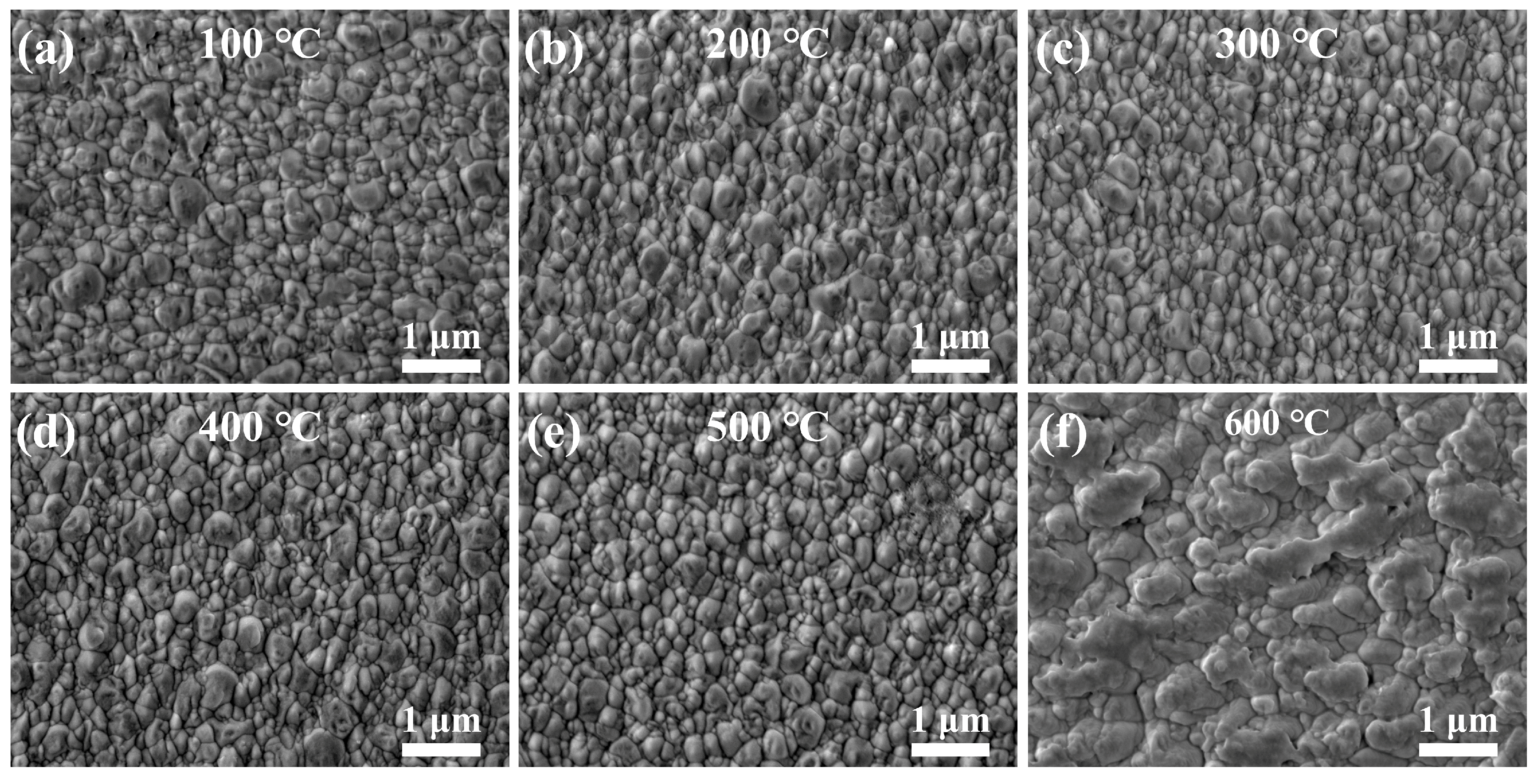
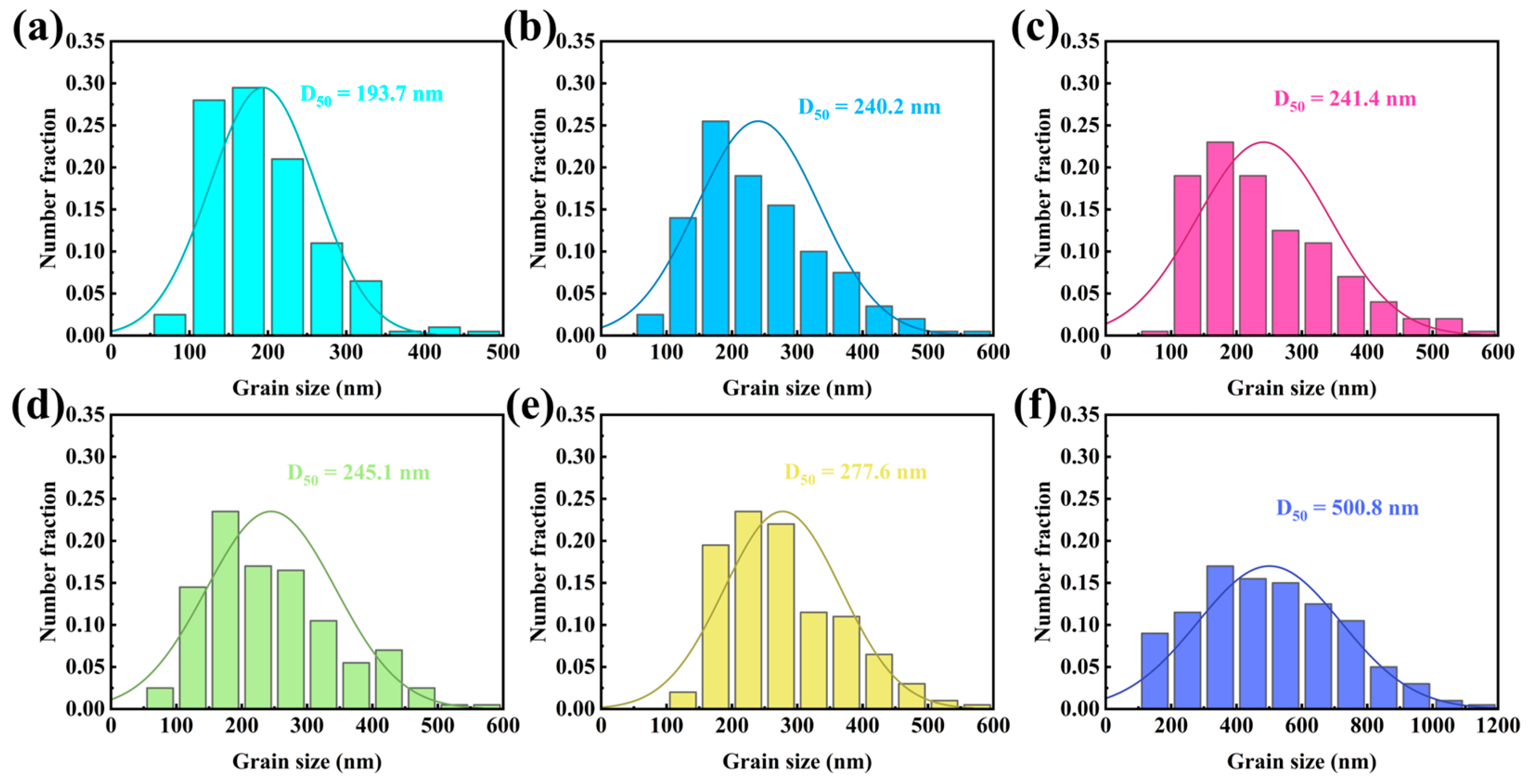



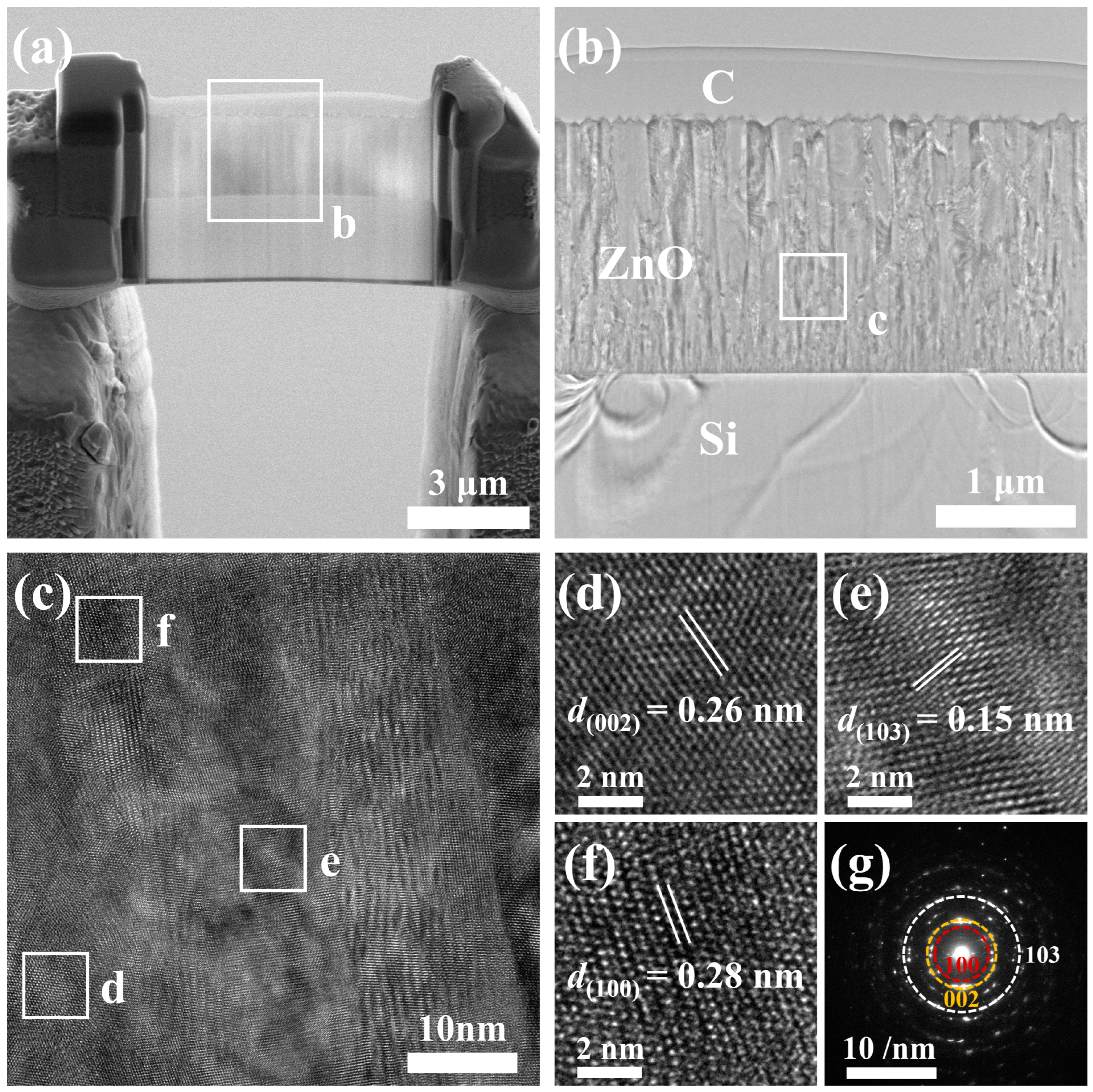
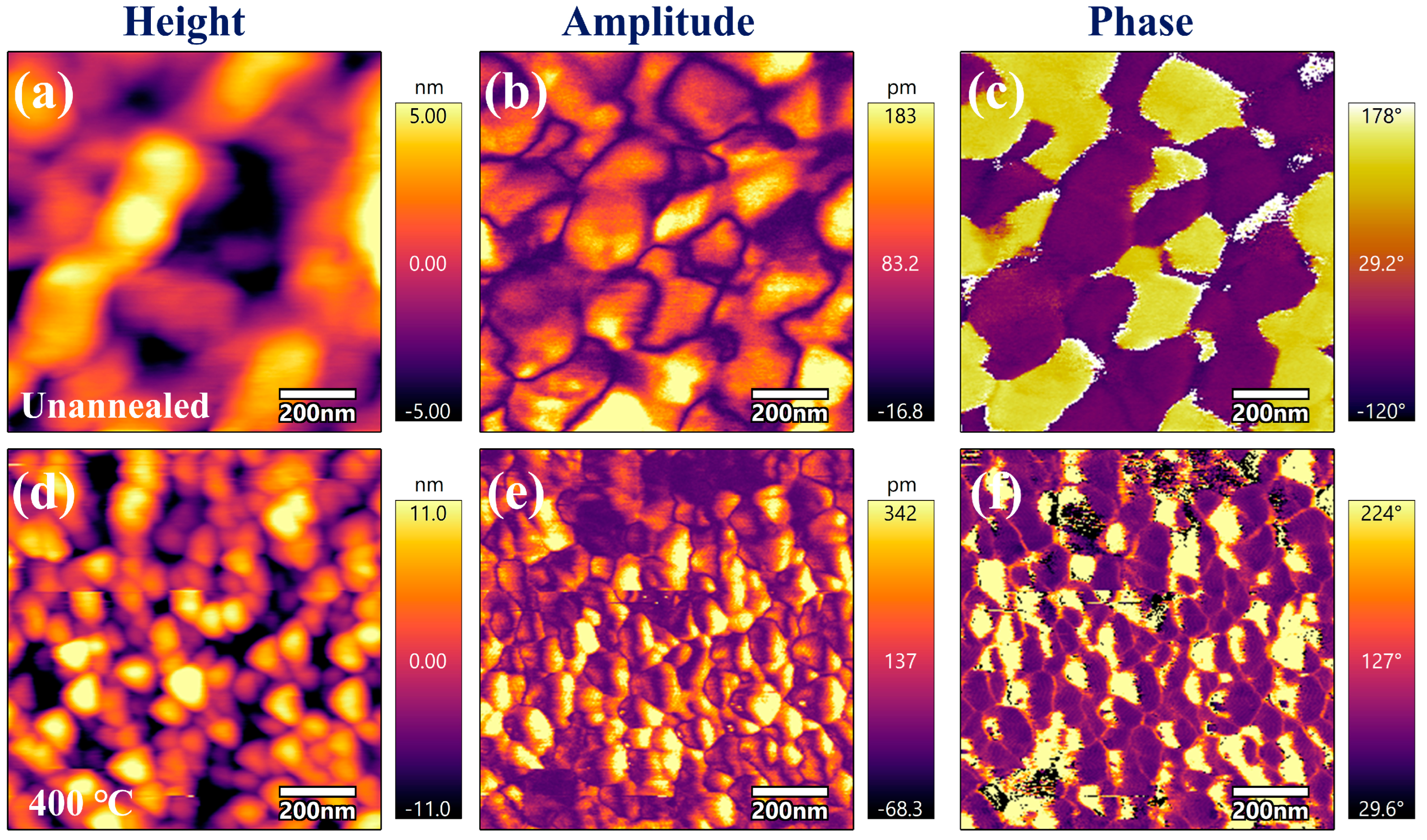
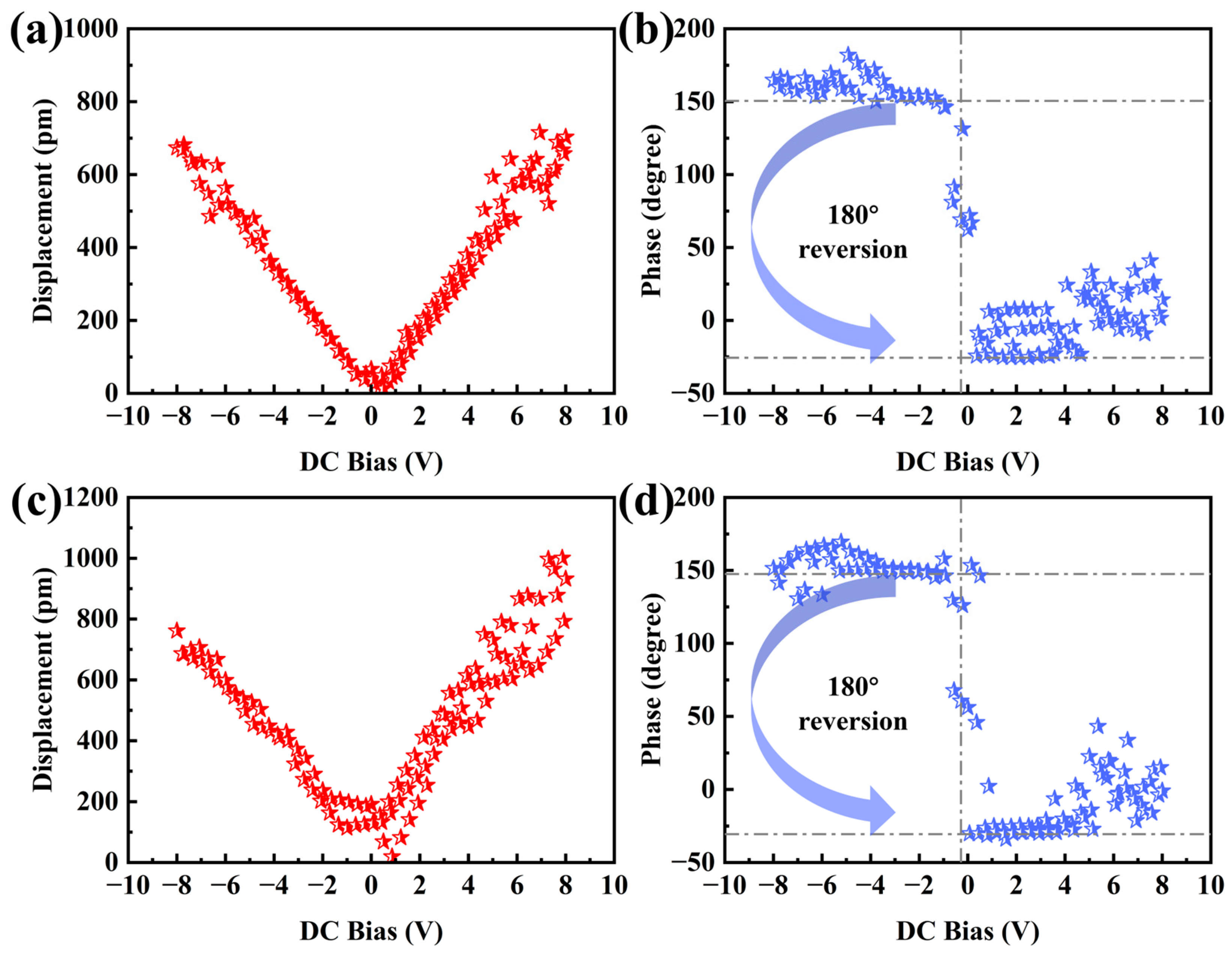
Disclaimer/Publisher’s Note: The statements, opinions and data contained in all publications are solely those of the individual author(s) and contributor(s) and not of MDPI and/or the editor(s). MDPI and/or the editor(s) disclaim responsibility for any injury to people or property resulting from any ideas, methods, instructions or products referred to in the content. |
© 2025 by the authors. Licensee MDPI, Basel, Switzerland. This article is an open access article distributed under the terms and conditions of the Creative Commons Attribution (CC BY) license (https://creativecommons.org/licenses/by/4.0/).
Share and Cite
Deng, K.; Liu, Z.; Liu, H.; Chen, Y.; Li, S.; Guo, S.; Xiu, B.; Dong, X.; Cao, H. Temperature Dependence on Microstructure, Crystallization Orientation, and Piezoelectric Properties of ZnO Films. Sensors 2025, 25, 242. https://doi.org/10.3390/s25010242
Deng K, Liu Z, Liu H, Chen Y, Li S, Guo S, Xiu B, Dong X, Cao H. Temperature Dependence on Microstructure, Crystallization Orientation, and Piezoelectric Properties of ZnO Films. Sensors. 2025; 25(1):242. https://doi.org/10.3390/s25010242
Chicago/Turabian StyleDeng, Ke, Zhonghao Liu, Hulin Liu, Yanxiang Chen, Shang Li, Shuren Guo, Boyu Xiu, Xuanpu Dong, and Huatang Cao. 2025. "Temperature Dependence on Microstructure, Crystallization Orientation, and Piezoelectric Properties of ZnO Films" Sensors 25, no. 1: 242. https://doi.org/10.3390/s25010242
APA StyleDeng, K., Liu, Z., Liu, H., Chen, Y., Li, S., Guo, S., Xiu, B., Dong, X., & Cao, H. (2025). Temperature Dependence on Microstructure, Crystallization Orientation, and Piezoelectric Properties of ZnO Films. Sensors, 25(1), 242. https://doi.org/10.3390/s25010242





